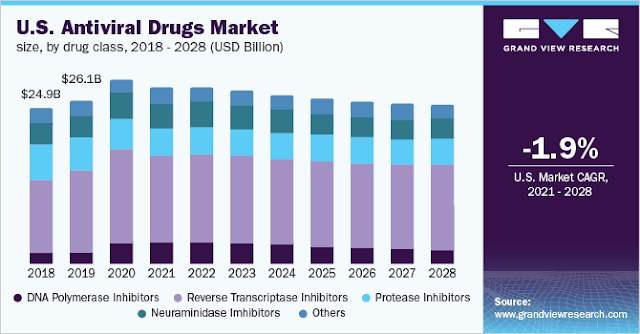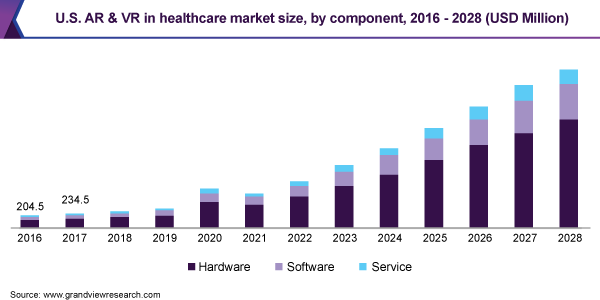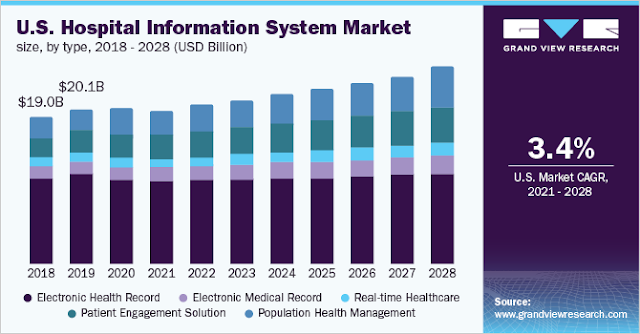Antiviral Drugs Industry Overview
The global antiviral drugs market size to be valued at USD 60.0 billion by 2028 and is expected to grow at a compound annual growth rate (CAGR) of (-0.6%) during the forecast period. The introduction of the generic version of antiviral medicines and growing awareness about the availability of various vaccines for viral infections is affecting the growth during the forecast period.
However, the increasing prevalence of viral infections such as HIV, Herpes, Influenza, and others are expected to increase the demand for antiviral medicines over the forecast period. For instance, according to UNAIDS, in 2020, more than 37 million individuals were living with HIV across the globe. Out of these, approximately 1.5 million new people acquired HIV infection in 2020. Overall, the COVID-19 pandemic has significantly increased market growth in 2020 whereas, a negative impact of the pandemic has been observed for other applications of antiviral drugs.
The increasing incidence of viral infection across the globe is a major factor driving the demand for antiviral drugs over the forecast period. According to WHO, globally, an estimated 325 million people are living with hepatitis infection and out of these, around 71 million have chronic hepatitis C virus infection. Moreover, the U.S. Department of Health and Human Services has estimated that 2.4 million people are living with hepatitis C in the United States and around 850,000 individuals in the country have hepatitis B infection. An increasing base of patients is anticipated to increase the demand for antiviral drugs globally.
Gather more insights about the market drivers, restrains and growth of the Global Antiviral Drugs Market
Increasing approval and expected commercialization of novel medicines for viral infections are anticipated to drive market growth. For instance, in November 2020, the U.S. FDA has approved a supplemental New Drug Application for Roche’s Xofluza for the treatment of influenza in patients 12 years of age and older. Moreover, the major players in the market have launched many novel medicines in 2 to 3 years for the treatment of viral infections. For instance, Gilead Sciences, Inc. has launched Biktarvy, Symtuza, and Veklury for the treatment of viral infections. Furthermore, GlaxoSmithKline plc. has launched Dovato, Cabenuva, and Juluca for the treatment of diseases caused by the virus. An increase in the introduction of novel products in the market will drive growth over the next 2 to 3 years.
The outbreak of the COVID-19 pandemic has significantly increased the demand for antiviral medicines globally. The treatment of novel coronavirus has increased the demand for broad-spectrum antiviral drugs to manage the disease. Remdesivir, favipiravir, oseltamivir, and other combination medicines are highly prescribed for the treatment of COVID-19. Moreover, governments are increasing funding to pharmaceutical companies to develop novel therapeutics against COVID-19. For instance, in June 2021, the U.S. government has announced an investment of more than USD 3 billion to fasten the discovery, development, and manufacturing of antiviral medicines for COVID-19 treatment. The rising incidence of disease coupled with increasing R&D will increase the demand for antiviral drugs in the next 2 to 3 years.
Increasing collaborations for the development and manufacturing of antiviral drugs are expected to result in the development of a high number of novel drugs in the coming years. The key players in the market are collaborating for the R&D of new therapies to reduce the burden of viral infection treatment. For instance, in 2020, Gilead Sciences, Inc. has signed licensing agreement with pharmaceutical manufacturers such as Cipla Ltd., Hetero Labs Ltd., Dr. Reddy's Laboratories Ltd., Mylan, and others to expand the supply of remdesivir.
Browse through Grand View Research's Pharmaceuticals Industry Research Reports.
• Immunotherapy Drugs Market: The global immunotherapy drugs market size was valued at USD 110.55 billion in 2021 and is expected to expand at a compound annual growth rate (CAGR) of 6.92% from 2022 to 2030. The market is primarily driven by the rising incidence of chronic diseases globally.
• Topical Drugs Market: The global topical drugs market size was valued at USD 97.42 billion in 2021 and is expected to grow at a compound annual growth rate (CAGR) of 10.1% from 2022 to 2030. The industry growth is primarily driven by the rising incidence of skin disorders and diabetes. According to the British Journal of Dermatology, skin diseases affect almost one-third of the global population.
Antiviral Drugs Market Segmentation
Grand View Research has segmented the global antiviral drugs market on the basis of drug class, type, application, and region:
Antiviral Drug Class Outlook (Revenue, USD Million, 2017 - 2028)
• DNA Polymerase Inhibitors
• Reverse Transcriptase Inhibitors
• Protease Inhibitors
• Neuraminidase Inhibitors
• Others
Antiviral Drugs Type Outlook (Revenue, USD Million, 2017 - 2028)
• Branded
• Generics
Antiviral Drugs Application Outlook (Revenue, USD Million, 2017 - 2028)
• HIV
• Hepatitis
• Herpes
• Influenza
• Others
Antiviral Drugs Regional Outlook (Revenue, USD Million, 2017 - 2028)
• North America
• Europe
• Asia Pacific
• Latin America
• Middle East & Africa
Key Companies profiled:
Some prominent players in the Global Antiviral Drugs Market include
• F. Hoffmann-La Roche Ltd.
• GlaxoSmithKline plc
• AbbVie
• Merck & Co., Inc.
• Johnson & Johnson Services, Inc.
• Bristol-Myers Squibb Company
• Cipla Inc.
• Aurobindo Pharma
• Dr. Reddy’s Laboratories Ltd.
Order a free sample PDF of the Antiviral Drugs Market Intelligence Study, published by Grand View Research.





